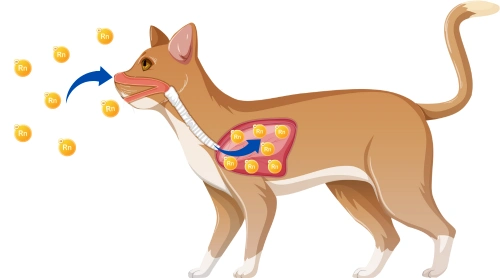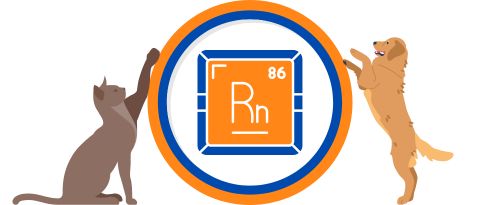Key Takeaways
Radon is a radioactive gas that can accumulate in homes, posing serious health risks to both humans and pets.
Pets may be more vulnerable to radon exposure due to their prolonged time spent indoors.
Radon levels vary significantly based on location, season, temperature, humidity, precipitation, and atmospheric pressure.
Scientific research on radon’s effects on pets is limited, but current evidence suggests potential risks.
Home radon levels should be regularly tested, and continuous monitoring is recommended.
Effective mitigation strategies include improving ventilation, sealing entry points, and consulting professionals for reduction systems.
What is Radon?
Radon is a colorless, odorless radioactive gas that originates from the natural decay of uranium in soil and rocks. It can infiltrate homes through cracks in foundations, gaps around pipes, and other openings, accumulating to levels that pose significant health risks. According to the World Health Organization, “Given the properties of radon, occupants of such buildings could unknowingly be living or working in very high radon levels.” Natural outdoor concentrations are 0.4 pCi/L. Experts consider this the ideal target for in-home concentrations. However, this is difficult to achieve. Average home concentrations in the United States is around 1.3 pCi/L. The EPA acknowledges there is no safe level, but any home in excess of 4 pCi/L should seek remediation. The World Health Organization’s action level is lower at 2.7 pCi/L.
State of Radon in the United States
Approximately 21,000 human deaths in the United States each year are due to radon-induced lung cancer. Radon-linked lung cancer is the second leading cause of lung cancer behind smoking. While the dangers of exposure to humans are well-documented, it’s crucial to recognize that our pets are equally vulnerable. According to the University of Georgia, “When people breathe this gas for many years, the radiation increases lung cancer risk. Pets spend much of their lives in homes and are also exposed to this same radioactivity.”
The Impact of Radon on Pets

Recent research has highlighted a potentially concerning link between radon exposure and primary lung tumors in pets. A study analyzing data from veterinary colleges identified 690 cases of primary pulmonary neoplasia (PPN) in dogs and 205 in cats. The findings revealed that pets residing in areas with high levels, according to the EPA, had approximately double the incidence of PPN compared to those in regions with lower levels of the radioactive gas.
This suggests that prolonged exposure to elevated levels increases the risk of lung cancer in pets. Given that pets often spend more time indoors than their human counterparts, their continuous exposure to indoor air pollutants like radon makes them particularly susceptible.
There is currently a lack of scientific research into the effects exposure has on our pets. Even the current research has limitations establishing individual home levels, factoring in confounding factors such as exposure to second-hand smoke, etc. It is certainly too early to conclude definitively to true risks of radon to our pets. Despite that, the current evidence suggests our pets are susceptible to the radioactive gas. Therefore, radon and other air quality factors should be considered when evaluating the safety of our homes for ourselves as well as our pets.
Factors Influencing Indoor Radon Levels
Radon concentrations within homes are not static; they fluctuate based on various environmental factors. According to the World Health Organization, “Radon concentrations vary considerably between adjacent buildings, as well as within a building from day to day and from hour to hour.” Below are some of the main factors influencing this variability:
Location: Geological formations rich in uranium can lead to higher emissions. Homes built on such terrains are at an increased risk. However, it is important to realize that radon levels vary wildly from location to location. This means even neighbors may have very different exposures. Even with a single house, the concentration of the dangerous gas can vary wildly depending on numerous factors.
Seasonal Changes: Radon levels often rise during colder months. This is attributed to the “stack effect,” where warm air escapes from the upper parts of a home, drawing in radon-laden air from the ground into lower areas. Winter months may lead to high gas levels as well due to a reduction in ventilation rates.
Temperature and Atmospheric Pressure: Lower outdoor temperatures and atmospheric pressure can increase indoor radon concentrations. Studies have shown that outdoor temperature and atmospheric pressure are significant factors affecting indoor gas concentrations.
Humidity and Precipitation: Humidity and precipitation can also influence indoor gas concentrations, but their exact impact depends on various factors, including ventilation, soil composition, and home construction. Experts generally believe that increasing humidity raises radon levels.
Mitigation Strategies to Protect Your Household
To safeguard both human and animal inhabitants from the dangers of radon, consider the following steps:
- Testing: The first line of defense is awareness. Given the variability of radon levels, continuous monitoring is advisable. Devices like those from Airthings offer real-time data, allowing homeowners to track fluctuations and respond promptly. We personally have used the Airthings Corentium Home for years with our own concentrations ranging over time between 0.1 pCi/L and 4.2 pCi/L.
- Ventilation: Enhancing airflow can help disperse the radioactive gas. Regularly open windows and use fans to promote air exchange, especially in lower levels of the home where the gas tends to accumulate.
- Seal Entry Points: Inspect your home for cracks in floors, walls, and foundations. Sealing these gaps can reduce the ingress of the gas. Pay special attention to areas where utilities enter the home, as they can serve as pathways for radon entry.
- Professional Mitigation: If elevated concentrations persist, consult certified radon mitigation professionals. They can install specialized systems, such as sub-slab depressurization, which effectively reduce indoor radon concentrations.
Conclusion
Protecting your home from this radioactive gas is not just a matter of human health, but also a crucial step in ensuring the wellbeing of your pets. By understanding the sources and factors influencing concentrations and implementing proactive mitigation strategies, you can create a safer environment for all members of your household.
